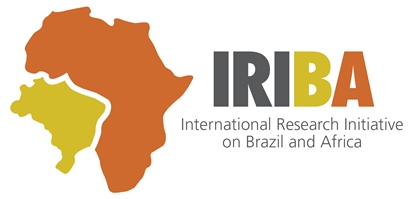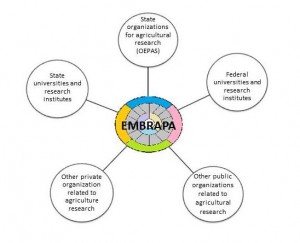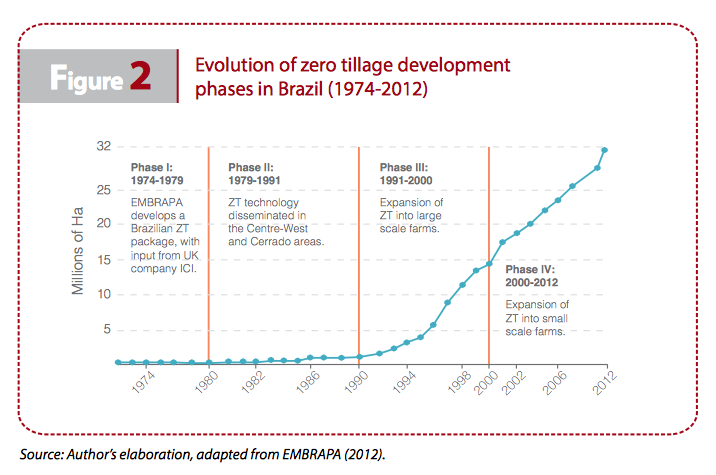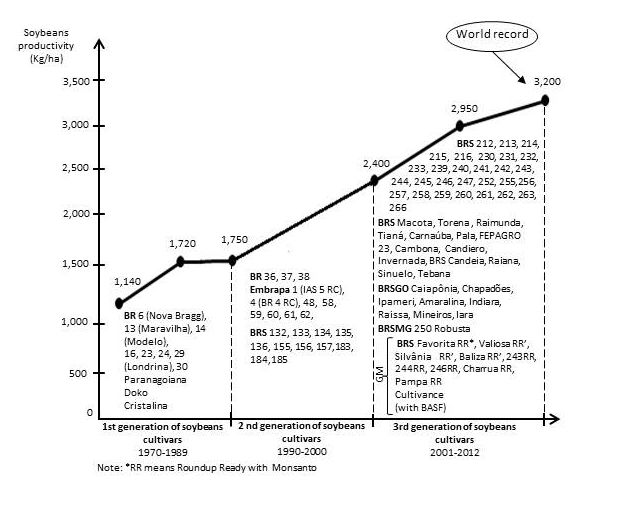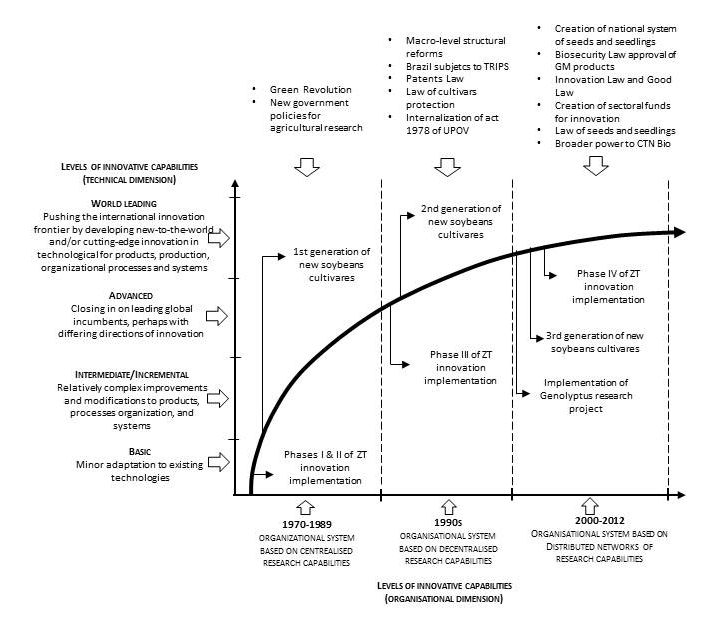This overview is based on the journal article ‘New challenges for public research organisations in agricultural innovation in developing economies: Evidence from Embrapa in Brazil’s soybean industry’, by Paulo N. Figueiredo.
The issues
While there has been an unprecedented increase in demand for agricultural produce around the world, productivity growth has been slowing down. Globally, productivity is expected to rise by just 1 per cent a year over the next two decades, much slower than historical trends (IMF 2014). Meeting the likely demand for food and fuel in 2030 will require an additional 175–220 million hectares of cropland (FAO 2014; Heck and Rogers 2014).
An alternative way to meet the growing demand for resources over the next decades will be to expand innovation capabilities and institutional infrastructures to deliver large-scale and high-productivity crops, especially in developing economies. Yet the next so-called green revolution should also bring the benefits of agricultural innovation and research to the poorest farmers across the developing world.
This article summarises the main results of an exploratory study on the role of indigenous institutional infrastructures (knowledge-related institutions and government policies) in the accumulation of world-leading innovative capabilities (technological catch-up) in latecomer natural resource-related industries. These issues are examined from the perspective of the Brazilian Corporation for Agricultural Research (EMBRAPA) and Brazil’s soybean and forestry-based pulp and paper industries.
The role of EMBRAPA
Brazil is the world’s second largest soybean producer (behind the USA) and the world leader in soybean productivity (kg/ha). In the 2012/13 crop Brazil produced 81.5 million tonnes of soybeans, while the USA produced 82.1 million tonnes. Brazil’s soybean production grew by 9.3 per cent from 2008/09 to 2012/13, while US production grew by 0.43 per cent over the same period. Brazil produces a quarter of the world’s soybean exports on just 6 per cent of the country’s arable land.
By 2012, the overall average yield for soybeans in Brazil (3,000 kg/ha) surpassed the average yield in the USA (2,800 kg/ha). The cost of producing soybeans in Brazil fell to about USD6.23 per 60 kg bag, around half of the US cost of USD11.72 (CONAB, 2013). EMBRAPA has played a significant role in achieving such impressive productivity gains.
Innovation in agricultural processes: adoption of zero tillage technology
Zero tillage (ZT) means planting with minimum soil disturbance, coverage of soil with plants and plant residues and rotation of crops. By 2009, Brazil had 25.5 million hectares of ZT-cultivated area, slightly more than the USA. ZT is sensitive to local ecological conditions, so Brazil could not simply replicate the same technique adopted in other countries. To adopt the ZT technique, Brazil had to engage in a process of creative imitation. This adoption process involved four phases (see Figure 2).
Brazil’s forestry-based pulp and paper industry: competitiveness and innovation
Brazil is the world’s largest producer of hardwood pulp (‘eucalyptus pulp’), the world’s fourth largest pulp producer and the ninth largest paper producer. Of the pulp and paper produced in Brazil, 100 per cent is derived from planted forests, which are renewable resources. Brazil has 2.2 million hectares of fully certified land planted for industrial use. In 2012, the revenue from Brazil’s pulp and paper industry approached USD17 billion, yielding exports of USD7.2 billion. From 1970 to 2012, Brazil’s output of pulp grew by an average of 6.8 per cent and of paper by an average of 5.4 per cent per year (Bracelpa 2014).
In the forestry-based pulp and paper industry, EMBRAPA played a more significant role after leading firms accumulated world-class innovative capabilities. By the late 1990s, Brazil had already consolidated its world-leading technological position in the eucalyptus-derived pulp and paper industry.
During the early 2000s, EMBRAPA Forestry and EMBRAPA Genetic Resources and Biotechnology led a remarkable nationwide research project on the eucalyptus genome. The Genolyputs network established a collection of over 150,000 DNA sequences generated from genes and genomes of four species of eucalyptus.
In addition to being an important organisational innovation for the forestry-based pulp and paper industry, Genolyptus also generated:
- the development of new human capital (e.g. MScs and PhDs);
- the development of new techniques for assisted molecular breeding;
- the development of new techniques for improving the quality of wood;
- new techniques for the physical analysis of wood; and
- an organised network of researchers.
Relevance of increased technological capabilities
The aforementioned innovative activities have been implemented based on technological capabilities accumulated by EMBRAPA and increasingly distributed among its partners. These technological capabilities have a technical dimension centred on human resources, skills and knowledge bases, and an organisational dimension centred on different forms of specialisation/differentiation, integration/co-ordination and ‘orchestration’.
As shown in Figure 4, as EMBRAPA’s innovative capabilities increased, its organisational structure developed from a centralised approach towards more networked research capabilities. The accumulation and strengthening of this organisational basis over time has been decisive to support innovative activities in these two industries. Figure 4 also suggests that the accumulation of these innovative technological capabilities has been influenced by changes in government policies, particularly since the 1990s.
Conclusions and policy implications
In closing, the study has found that in agriculture, public research organisations play an important role in catalysing industrial innovation. However, they need to work together with key industry stakeholders to meet their needs and demands.
Moreover, while investment in science is not a guarantee for achieving relevant innovative performance, policymakers should adopt a comprehensive perspective on innovation based on a spectrum of activities: from duplicative copy, creative imitation to progressive levels of innovation. Important innovative activities can be implemented on the basis of capabilities other than research and development.
Natural resource-related industries offer important opportunities for innovation and for achieving international competitiveness. Achievements in this area depend on the accumulation of innovative capabilities, connected with market needs and demands, at the level of industry and organisations. They also depend on the design and implementation of government policies to stimulate, support and fund the development of these capabilities.
References
Bracelpa. 2014. Brazilian pulp and paper industry. São Paulo: Associação Brasileira de Celulose e Papel. Accessed 27 October 2015.
CONAB (Companhia Nacional do Abastecimento). 2013. Indicadores da Agropecuária. Ano XXXII, No. 7
EMBRAPA. 2012. Relatório Anual de Atividades. Brasília: Empresa Brasileira de Pesquisa Agropecuária.
Heck, S., and M. Rogers. 2014. ‘Are you ready for the resource revolution?’ McKinsey Quarterly, March 2014.
IMF. 2014. World Economic Outlook. Washington, DC: International Monetary Fund. Accessed 27 October 2015.
